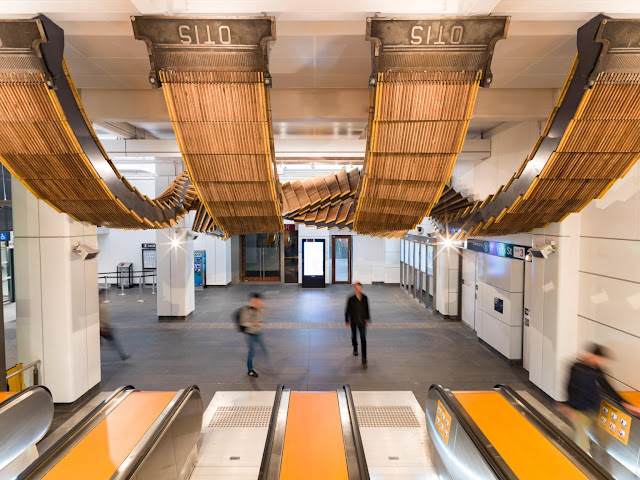___________________
A New Banksy:
Well known street artist Banksy, who has now become respectable and whose works fetch big $$$, has confirmed that he is responsible for a Christmas street art work on a garage wall in Port Talbot in Wales.
The work shows a young lad warmly clothed for the cold weather, with a sled, trying to catch snowflakes on his tongue:
Turn the corner and a different work is revealed:
Here is the work in its entirety:
Banksy uploaed an image of it onto his website. A video was also posted on the artist’s Instagram account showing the mural accompanied by the children’s Christmas song Little Snowflake. The camera rises above the garage and shows Port Talbot’s rooftops and industrial works wreathed in smoke.
This year, the World Health Organisation said Port Talbot was the most polluted place in the UK. But in May, Neath Port Talbot council said the WHO got the figures wrong and had apologised.
Meanwhile the owner of the garage, Ian Lewis, who built the garage in 1990 to stop his car being vandalized, is wondering what to do with his new treasure. With the assistance of actor Martin Sheen, screens have been put up to protect it. A drunk who tried to deface it was chased away by security. The local council is wondering what it can do to preserve it. . . .
Ian Wilson
Security fence . . .
. . . and perspex.
___________________
From:
Half a Century in the Making: Tree ‘Crop Circles’ Emerge in Japan
From a website called Colossal:
Two peculiar ‘crop circles’ have recently been spotted in Japan’s Miyazaki Prefecture. Viewable only from above, they were formed by sugi (Japanese cedar) trees. Conspiracy theorists will be disappointed to learn that there is a very practical explanation for how these shapes emerged: science. Specifically, it was the result of a scientific experiment that spanned close to 50 years.
According to documentation . . . obtained from Japan’s Ministry of Agriculture, Forestry and Fisheries, in 1973 an area of land near Nichinan City was designated as “experimental forestry” and one of the experiments was to try and measure the effect of tree spacing on growth. The experiment was carried out by planting trees in 10 degree radial increments forming 10 concentric circles of varying diameters.
Part of what makes the crop circles so alluring are their concave shape, which was an unexpected result of the experiment that would suggest tree density does indeed affect growth. The trees are due to be harvested in about 5 years but officials are now considering preserving the crop circles.
https://www.thisiscolossal.com/2018/12/tree-crop-circles-emerge-in-japan/?mc_cid=2d71db7ec4&mc_eid=0b0e554f8d
___________________
Also from Colossal:
When the Sun Sets in Baiona, a Seemingly Simple Whale Mural Reveals a Belly Full of Sailors
A new collaborative mural by Barcelona-based artists María López and Javier de Riba undergoes a dramatic shift from day to night. Titled Hizkuntza, the mural appears to be a simple outline of a whale by day, but darkness reveals an intricate glowing design. The placement of the whalers inside the whale’s belly suggests an ambiguous power dynamic: did the whale swallow the sailors, or did they overtake the beast and turn it into a ghost of its former self?
The mural is located in Patxa Plaza in Baiona, a small city on the southwest coast of France that is a popular tourist destination. The Plaza in particular is a site of public gathering and celebration of Basque culture. In a description of the mural on Behance, the artists explain that they were inspired by the complex history of whaling. Commercial extinction of the Eubalena Glacialis whale in the Cantabrian Sea forced Basque sailors to explore new horizons, which created new languages like Basque-Icelandic and Algonquin-Basque.
López and de Riba often work in glowing paints, and focus on the culture and history of the locations where they install their murals.
https://www.thisiscolossal.com/2018/12/hizkuntza/?mc_cid=2d71db7ec4&mc_eid=0b0e554f8d
___________________
Final item from Colossal::
80-Year-Old Wooden Escalators are Repurposed as a Sculptural Ribbon by Artist Chris Fox
Artist Chris Fox was tasked with repurposing two pairs of timber escalators that were first installed at Sydney’s Wynyard Station in 1931. The escalators have carried passengers for over 80 years and slowly became an iconic symbol of the city’s identity. Fox’s solution is Interloop, a twisting, accordion-like ribbon that is now suspended from the station ceiling, stitching together 244 wooden escalator treads in an otherworldly design.
Fox says Interloop is intended to permanently enshrine the motion of the escalators while also communicating that passengers remain stationary while riding them. The piece is the final step in a significant overhaul of the station that now features new elevators and escalators, a larger concourse, and improvements to ventilation and ticketing.
https://www.thisiscolossal.com/2017/12/interloop-escalator-sculpture/?mc_cid=2d71db7ec4&mc_eid=0b0e554f8d
















No comments:
Post a Comment
Note: Only a member of this blog may post a comment.